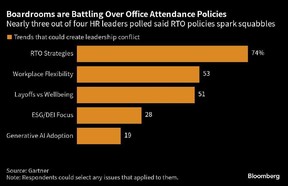Oct. 11, 2023 "Return-to-office policies may create boardroom brawls, HR execs say": Today I found this article by Matthew Boyle on the Financial Post:
Nearly three out of four organizations said return-to-office policies could prompt boardroom battles, according to a new survey of United States workplace leaders, showing how senior management doesn’t always see eye to eye on the issue.
RTO mandates were cited as the issue that had the greatest potential to foment conflict among leaders, the September poll of 170 human resources executives by workplace consultant Gartner Inc. found.
Those policies came ahead of such charged topics as
layoffs,
debates about diversity
and ESG,
and the adoption of generative AI.
The majority of those polled also said that office attendance policies had increased tension between teams, possibly because just one-third of firms had trained their managers to address the many challenges that arise when workers are called back to the office more often.

“Leaders just don’t agree on what the requirements should be,” said Caitlin Duffy, a research director at Gartner’s human resources practice.
“There is so much variation across
teams,
functions
and the nature of what roles require.
Managers have been left to figure it out for their teams and that’s hard.”
The findings, coming amid RTO ramp-ups at many firms, illustrate that opinions about the value of in-office work can differ even at the top of the organizational chart.
High-profile CEOs like Walt Disney Co.’s Bob Iger and Jamie Dimon of JPMorgan Chase & Co. have extolled the benefits of on-site work, and a recent survey of
400 U.S. CEOs from auditor KPMG found that nearly two in three envision all corporate employees to be back in offices full-time in the next three years.
Some firms, like Alphabet Inc.’s Google, have said that attendance will be incorporated into employee performance reviews.
Yet not all corporate chiefs are convinced that compelling people back is the best policy.
“I don’t work well in an office, it just doesn’t work with my personality,” Salesforce Inc. chief executive Marc Benioff said last month.
“For my people that’s my message. They need to mix in person and remote together.”
Last year, an executive at Apple Inc. who oversaw machine learning and artificial intelligence left the iPhone maker over the company’s return-to-office policy.
Workers, by and large, aren’t coming back at the pace some leaders anticipated: Average office attendance across 10 big U.S. cities still stands at about 50 per cent of pre-pandemic levels, according to security firm Kastle Systems International LLC, no higher than where it was early in 2023.
The Gartner survey also found that workers are growing more likely to leave their jobs, with
nearly one in three firms saying their organization experienced more voluntary departures in September compared with the previous three months,
up from one in five who said so in June.
The uptick contrasts with the quit rate as measured by the government’s monthly job-openings report, which has steadily declined from last year’s high until stabilizing in August.
The rising quit rate in Gartner’s survey suggests that workers are either
gaining confidence in their ability to find another job in the current labour market
— or that they are so discontent at work that they see quitting as a viable option.
Hiring surged in September, while unemployment remained low and the pace of layoffs slowed.
Along with the resilient labour market, dissatisfaction with RTO policies could play a factor in some employees’ decisions to quit, Duffy said.
More than four in 10 employers who implemented RTO mandates have experienced higher than normal attrition rates, according to a survey of 6,650 employers from Unispace, a workplace strategy and design firm.
The HR leaders also said they’re more concerned about employee stress and burnout,
but few were implementing preventive measures to reduce them,
like redesigning roles
or identifying tasks that lead to excessive stress.
Instead, most firms are providing benefits like counselling, but only after a problem emerges.
Bloomberg.com
https://financialpost.com/fp-work/return-to-office-boardroom-brawls
Chief executive Bob Sulentic said companies such as CBRE are seeking to balance in-person work with the recognition that people don’t want to spend hours in traffic.
“We’re still trying to figure out what the optimal place is,” he said during a panel Nov. 9 hosted by the Dallas Regional Chamber.
The rise in remote work since the pandemic has had far-reaching implications for the real estate industry, including property owners that Sulentic’s company counts as clients.
Office landlords have been confronting declining tenant demand as more companies adopted remote-work policies.
That’s pushed the office vacancy rate in the United States up to 18.4 per cent in the third quarter, according to CBRE.
Landlords have also been pressured by the rise in borrowing costs, which has contributed to a nearly 21 per cent decline in office prices in the 12 months through October, according to real estate analytics firm Green Street. Investors including Brookfield Asset Management Ltd. have defaulted on debt and walked away from buildings.
Sulentic said higher borrowing costs have dented commercial real estate valuations more than his firm originally forecast.
“We thought values may come down 15 per cent, 20 per cent. We now think that may be another 10 per cent,” Sulentic said.
He noted price declines were “most acute” for office buildings.
— With assistance from María Paula Mijares Torres.
perhaps there is an opportunity to repurpose unused commercial property into much needed residential property
No comments:
Post a Comment